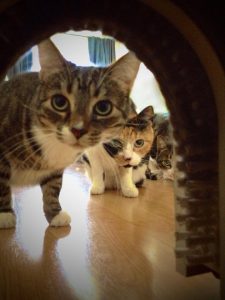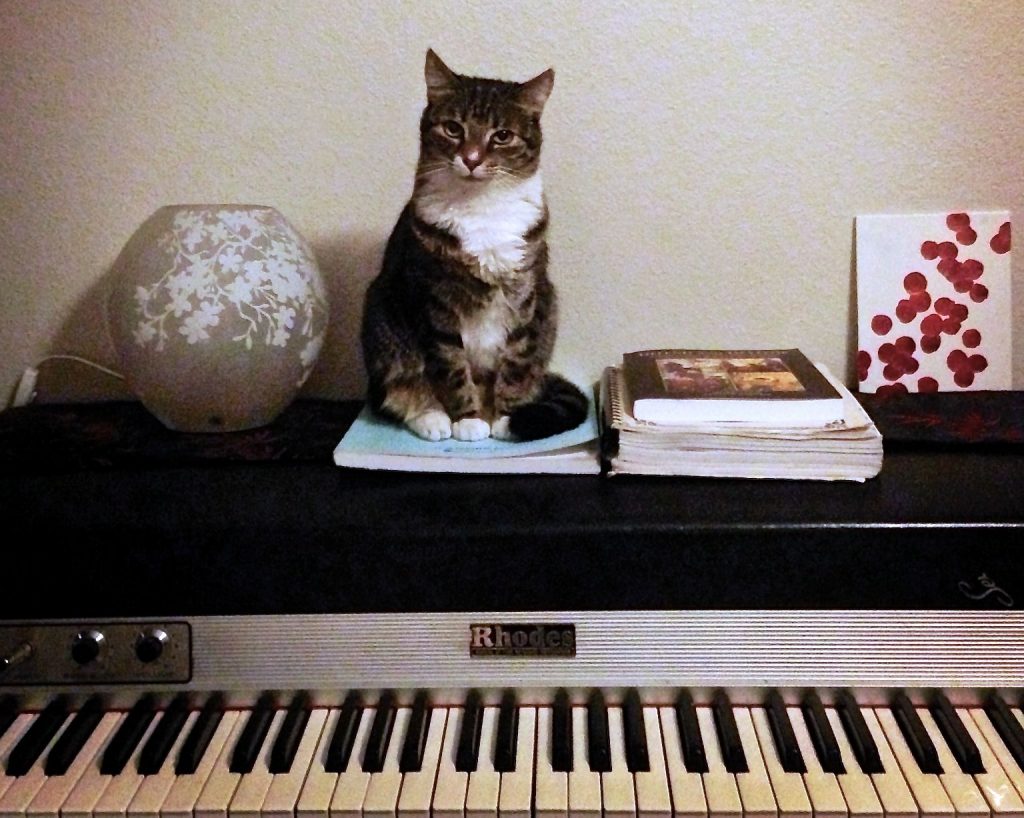Guest Contribution by April Tucker
Meet Yuki, one of my cats. She’s a tiny, feisty 6-year-old tabby. Earlier this year, we learned that Yuki had gone deaf after having normal hearing most of her life. She probably lost her hearing gradually, but it wasn’t obvious until one day when I was vacuuming and realized she was right by me, happily curled up and sound asleep.
There’s a learning curve to owning a deaf pet – especially a cat that’s already stubborn and sleeps in places you can’t find. Deaf pets get extremely startled if you touch them when they don’t perceive you first (through vibration, sight, or smell). Words that they responded to before (like “dinner” or “no”) suddenly have no meaning. Yuki became cautious, spending a lot of time just trying to gauge her surroundings (like the other cats who were unaware of her condition).
As an audio engineer, I naturally became curious and observant about what changed in her world without sound. When do we react to sound instinctually, and what is that reaction? Her deafness also made me question my own relationship with sound. Do we naturally favor communication through sound since it’s what we do for a job?
One of the first changes I noticed in Yuki (and the most dramatic) was how much calmer she was. For most cats, a doorbell, vacuum, or an unfamiliar voice sends them running under the bed before they even know the cause of their fear. Humans have the same rush of anxiety or “fight or flight” response when a loud or unfamiliar sound catches us off guard. It’s a trick that we utilize in sound design and sound mixing – How intense would a horror movie be without sound?

Watching Yuki, I realized that my perception of absolute silence was wrong. I used to shy away from total silence in sound design or mixing, assuming it would generally be disorienting to the listener. For Yuki (who lived in silence) it brought out curiosity. When one sense is taken away, we naturally move focus to our other senses. We also adapt to changes in our environment, so it’s just a matter of context if we’re alarmed or disoriented by it. I’m sure we’ve all been at a music concert or show that gradually got louder and louder without really noticing. Once you step outside the building (where there’s a drastic change in sound level), it’s totally obvious. The shift is what’s disorienting, not necessarily the silence.
With Yuki, we had to learn to communicate using senses other than sound. It’s so natural to use the voice (with words or just vocal intensity, like loud or calm) to get a message across quickly. Some new forms of communication came easily, like using hand signals (waving “hello” or “come here”) to attract her by vision. If she doesn’t hear me approach, I stomp on the floor or tap near her so she feels movement or vibration. If she’s asleep, I can put food near her and Yuki will jump to alert – the same reaction as when I used to say “dinner.”
It can be harder when you’re used to using sound to send an emotional message. I didn’t realize how much I used an excited voice to get her to play, or talked calmly when she was being skittish. She’s become sensitive to new smells or when something familiar moves out of place, and cries loudly to let us know. Other than petting (touch), what else can you do to communicate that everything is ok? Yuki communicates by sound differently, too – she talks at full volume all the time now, so every meow sounds like distress (even if she’s just saying hello). It’s forcing me to use senses beyond sound, too, because I have to look at her body language and environment to see what she’s actually trying to communicate.

Sound, in essence, is a conduit; it’s a means of getting a message from point A to point B. Sound is also a means of sending or receiving a message, just like sight, smell, taste or touch. It’s up to the sender to determine the message, which “conduit” to use, and to assess how the message will be received. For example, comfort food can be used to communicate a message. Foods can use taste or smell to elicit emotions, like security, relaxation, or love. But, what one person experiences as familiar might be exotic or have no meaning to someone else. A chef who specializes in comfort food has to consider: Who are his/her diners? What’s the message he wants to send, and how is it received? As sound people, we have the same consideration: How will an audience react to a sound when the intention is to provoke a specific emotion? A musical instrument that’s familiar and popular in one culture might be obnoxious and out of tune to another. A technology beep or ringtone may not have any meaning to other cultures, and it may not be relevant to our own in the future.
A message can change meaning depending on the environment, too. A warm blanket in the winter might be calming and soothing to the touch, but in the heat of summer, it could be uncomfortable and irritating. Add a layer of sarcasm or irony and communication can get even more complicated. An ominous ambience might evoke a sense of fear in one scene, but in another, the same sound makes the audience laugh. A message can cross over senses, too. A clapping sound may not have meaning to Yuki anymore, but she still responds if she feels the air movement. A loud subwoofer in a theater is sound-based, but it could be effective because it’s also utilizing touch (vibration).
There’s a lot more interplay between senses than we probably pay attention to – especially when our primary focus is on sound. Isn’t the nature of multimedia to create experiences that excite multiple senses? Do we need to step back more and ask, is sound the most effective sense to send this message, or how might it be combined with other senses? It might seem like an unusual question to ask, but what could the audience be feeling (physical sensations), tasting, or smelling? Can we impact those senses through our use of sound? It’s an interesting exercise to move the focus away from our two primary work senses (sound and sight). It’s something I probably wouldn’t have considered if it weren’t for Yuki.
—
A big thank you to April Tucker for this interesting perspective on sound, and the absence of sound.
April is a re-recording mixer (and audio nerd) in Los Angeles. She can be reached through her website, www.proaudiogirl.com or on Facebook https://www.facebook.com/proaudiogirl.

My boy went deaf about 5 years ago (he’s 20 now!!), and I went through the same thing. He became louder for a while, but over time we’ve developed our own system of touch, body language, and vibration. It’s amazing how much he’s changed and that I’ve changed as well to communicate with him. He never used to be a very touchy cat, but now he does little paw taps on me while I’m editing to let me know he wants me to pay attention.
Thanks for the article :)
Our little black kitty has been deaf all her life. All of the things you talk about in your article have been true with her . . . and the rest of the family, both human and cat. I have also noticed the other things that she clearly uses to get information. Opening the back door of the house so the cats can go into their yard, changes both the air pressure in the rest of the house, and the smell of the air. She clearly notices. Thanks, April, for sharing your insights on what we can learn from them about sound (and other sensory experiences)!
That’s a great observation – Yuki gets super excited when the doors and windows are open. I hadn’t realized that it’s probably from those changes in smell, temperature, etc. They’re very sensitive!
Another great article, April. I like the notion of affecting other senses through the use of sound rather than relying directly on it…